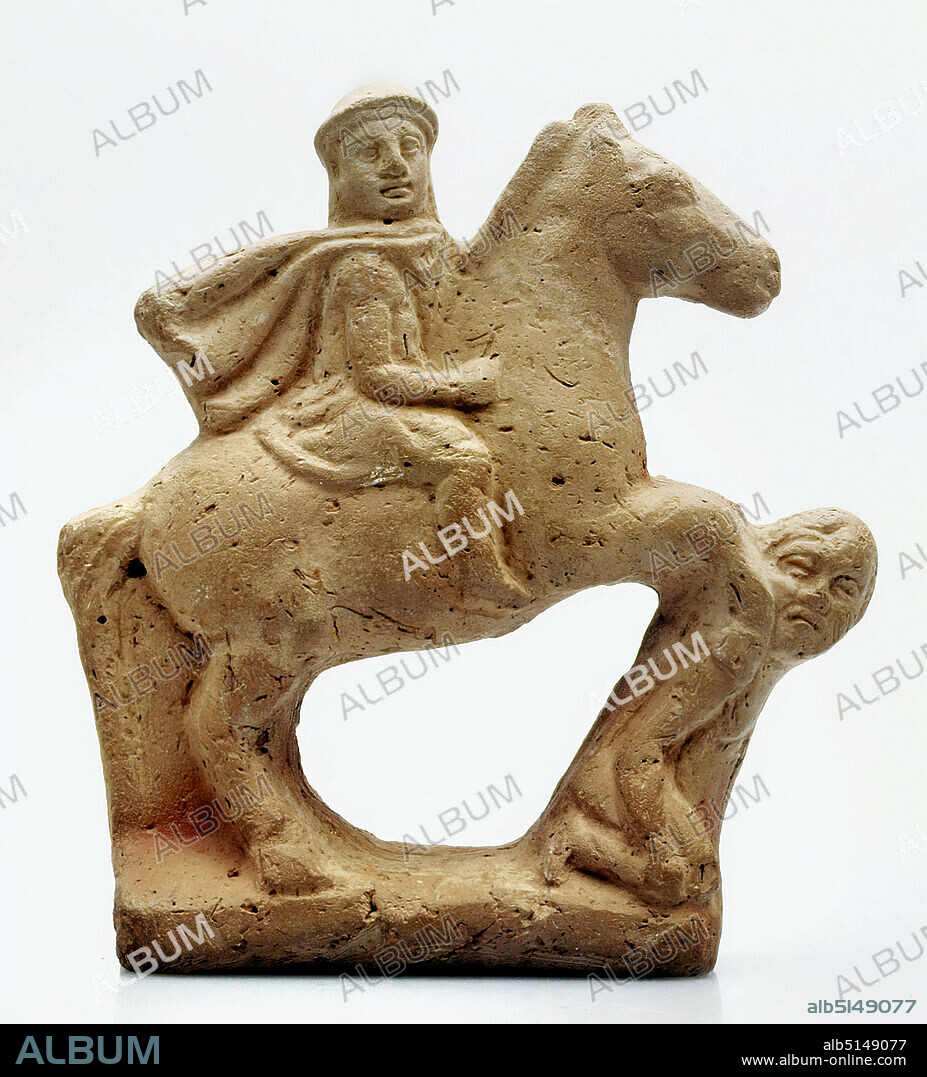alb5149077
Macedonian Horseman over an enemy, Clay, pressed into the mold, hand modeled, fired (pottery), Clay, Total: Height: 11.8 cm, Pottery, War, Riding (cavalry), Cavalry, Rider troops, Victory (armed conflict), Republican period, Early Imperial period, Middle Imperial period, On a flat base a rider gallops to the right. His horse has its front legs torn high into the air. Beneath it a man crouched on his knees. In the next moment the hooves seem to drum down on his shoulders and trample him completely to the ground. While the rider is dressed with a chiton, boots, a flat, beret-like headgear, the Macedonian causia, and a coat blowing backwards, which has been the Macedonian costume since Alexander the Great, his opponent is naked. His face shows asymmetrical features. The terracotta is probably based on a large-sculptural victory monument for Ptolemy I. Soter. The figure belongs to the group of the so-called Fayum terracottas. Alexandria, the international, Greek-influenced center of Egypt, is home to a multicultural society of Egyptians, Orientals, Greeks, Romans, Jews, and others, whose different religious ideas are gradually merging. Insights into this world of faith are provided by the so-called Fayum terracottas. They are part of the religious household, children's toys, knick-knacks, but also cult symbols, grave goods, pilgrimage images, votive offerings and magical objects for banishing evil forces. They can be found in houses, graves and sanctuaries.

|
Añadir a otro lightbox |
|
Añadir a otro lightbox |



¿Ya tienes cuenta? Iniciar sesión
¿No tienes cuenta? Regístrate
Compra esta imagen.
Selecciona el uso:

Descripción:
Ver traducción automática
Macedonian Horseman over an enemy, Clay, pressed into the mold, hand modeled, fired (pottery), Clay, Total: Height: 11.8 cm, Pottery, War, Riding (cavalry), Cavalry, Rider troops, Victory (armed conflict), Republican period, Early Imperial period, Middle Imperial period, On a flat base a rider gallops to the right. His horse has its front legs torn high into the air. Beneath it a man crouched on his knees. In the next moment the hooves seem to drum down on his shoulders and trample him completely to the ground. While the rider is dressed with a chiton, boots, a flat, beret-like headgear, the Macedonian causia, and a coat blowing backwards, which has been the Macedonian costume since Alexander the Great, his opponent is naked. His face shows asymmetrical features. The terracotta is probably based on a large-sculptural victory monument for Ptolemy I. Soter. The figure belongs to the group of the so-called Fayum terracottas. Alexandria, the international, Greek-influenced center of Egypt, is home to a multicultural society of Egyptians, Orientals, Greeks, Romans, Jews, and others, whose different religious ideas are gradually merging. Insights into this world of faith are provided by the so-called Fayum terracottas. They are part of the religious household, children's toys, knick-knacks, but also cult symbols, grave goods, pilgrimage images, votive offerings and magical objects for banishing evil forces. They can be found in houses, graves and sanctuaries.
Personas:
Crédito:
Album / quintlox
Autorizaciones:
Modelo: No - Propiedad: No
¿Preguntas relacionadas con los derechos?
¿Preguntas relacionadas con los derechos?
Tamaño imagen:
3910 x 4320 px | 48.3 MB
Tamaño impresión:
33.1 x 36.6 cm | 13.0 x 14.4 in (300 dpi)
Palabras clave:
ADORNO • ADVERSARIO • AIRE • ALEJANDRIA • ALEJANDRO • ALEXANDER • ALFARERIA • ARCILLA • BAJO • BASE PLANA • BOTA • BOTAS • CABALLERIA • CABALLO • CABALLOS • CARA • CASA • CASAS • CERÁMICA • CERÁMICO • CONFLICTO ARMADO • CONFLICTO BELICO • CREENCIA • DECORACION • DECORATIVO • DESNUDA • DESNUDAS • DESNUDO • DESNUDOS • DISPARARON • EGIPCIA • EGIPCIAS • EGIPCIO • EGIPCIOS • EGIPTO • ENEMIGO • EQUITACION • EXVOTOS • FACE • FE • GORRO • GRIEGOS • GROUP • GRUPO • GRUPO. • GUERRA • HOGAR • HOMBROS • INTERNACIONAL • JINETE • JUDIO • JUDIOS • MUNDO • OBJETO DE CERAMICA • ORNAMENTACIÓN • ORNAMENTO • PRESIONADO • RELIGION • RODILLAS • ROMANOS • ROSTRO • SHOULDERS • SUELO • TERRACOTA • TERRACOTTA • TUMBAS • VICTORIA • WAR
 Pinterest
Pinterest Twitter
Twitter Facebook
Facebook Copiar enlace
Copiar enlace Email
Email
